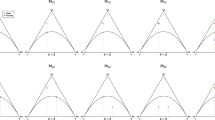Abstract
Some common errors in testing the departure of genotype frequencies from Hardy-Weinberg (random mating) expectations are pointed out and the difference between testing genotype frequencies and heterozygosities is stressed. We note that a statistical comparison of the expected and observed heterozygosities in the population is complicated by positive correlation between the estimates of the two values.
Similar content being viewed by others
Literature cited
Crisp, D. J., A. R. Beaumont, M. W. Flowerdew and A. Vardy: The Hardy-Weinberg test — a correction. Mar. Biol. 46, 181–183 (1978)
Curie-Cohen, M.: Estimates of inbreeding in a natural population: a comparison of sampling properties. Genetics, Austin, Tex. 100, 339–358 (1982)
Elston, R. C. and R. Forthofer: Testing for Hardy-Weinberg equilibrium in small samples. Biometrics 33, 536–542 (1977)
Emigh, T. H.: A comparison of tests for Hardy-Weinberg equilibrium. Biometrics 36, 627–642 (1980)
Smith, C. A. B.: A note on testing the Hardy-Weinberg law. Ann. hum. Genet. 33, 377–383 (1970)
Author information
Authors and Affiliations
Additional information
Communicated by G. F. Humphrey, Sydney
Rights and permissions
About this article
Cite this article
Pamilo, P., Varvio-Aho, S. Testing genotype frequencies and heterozygosities. Mar. Biol. 79, 99–100 (1984). https://doi.org/10.1007/BF00404990
Accepted:
Issue Date:
DOI: https://doi.org/10.1007/BF00404990




